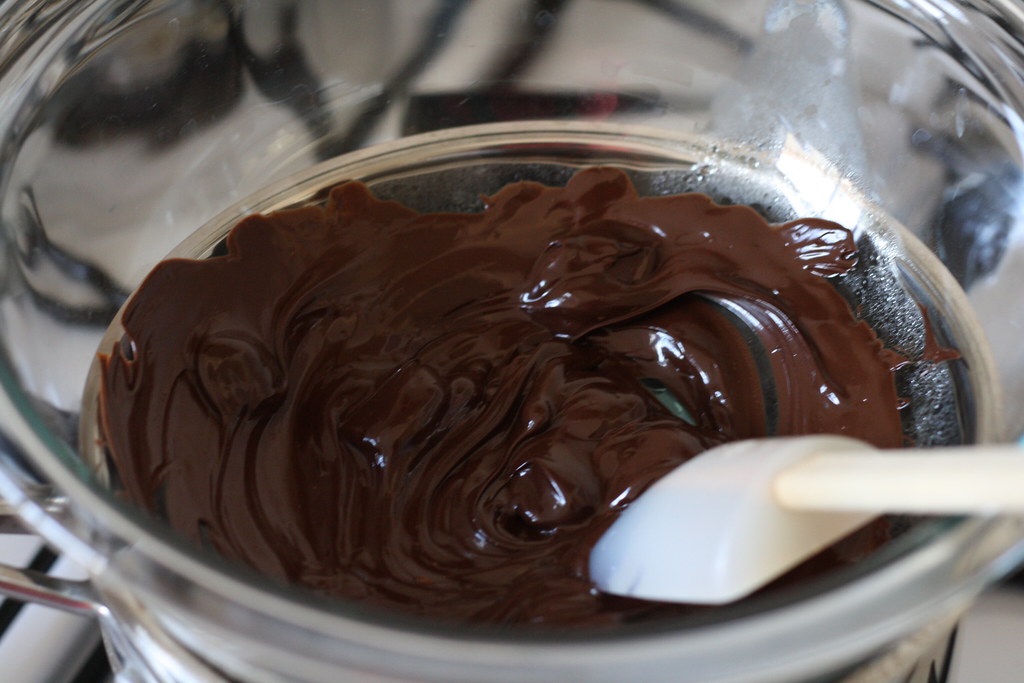How To Fix Seized Chocolate

Melting chocolate is a fine art. When it goes well, it’s amazing and perfect and I can’t help but feel accomplished. But when it goes wrong… well, it goes very wrong. I’ve done it right a million times, but that doesn’t mean that I still can’t mess it all up!
Like recently. For Father’s Day, I helped my mother-in-law make a type of German layer cake from my father-in-law’s childhood that he really loves. We were trying to make a ganache to top it all off. Just two ingredients. Dark chocolate, and heavy cream. Simple, right?
NO!!! I messed it up not just once, but twice! The first time I could tell it was getting clumpy and gritty and I figured I must not have broken up my chocolate small enough. So I used a sharp knife and cut the bar of chocolate extremely small- mostly shavings with just a few bigger chunks. I microwaved the cream and chocolate together in small increments- and it still clumped together!
We ended up not doing the ganache for time’s sake. But it’s been bugging me ever since!! What went wrong? Could I have saved it? Well, let’s dig a little into the science behind melting chocolate, and figure out how we can save it when it messes up!
There are actually two problems that you can run into when melting chocolate. Overheating, and seizing.
Seizing happens when moisture is introduced. Chocolate can be so finicky. When you are melting it, even the tiniest bit of water can throw off your mixture. When the chocolate is melting, the fat from the cocoa butter is breaking up evenly with the dry particles (the cocoa and sugar), and so even just a drop of water can throw everything off because the dry particles become moist and start sticking together- resulting in the gritty, clumpy mess you get when seizing chocolate.
Overheating happens when the chocolate gets too hot. This most often happens when using a double boiler and letting the water get too hot, or using a microwave on full power. This results in a dull (not shiny), muddy texture.
Both are a major bummer, but can be prevented! When heating chocolate, be extremely careful to avoid anything wet getting in contact with your chocolate. Dry off cutting boards and knives, be careful to dry your hands thoroughly after washing to prevent droplets, and use a dry bowl. It’s also best to avoid using wooden cutting boards and spoons, because these often retain moisture, which is going to mess with your chocolate!
Also, don’t put a lid or covering of any kind on warm melted chocolate because the condensation can also cause your chocolate to seize. And be sure to heat your chocolate with your wet ingredients to ensure that the dry particles stay sufficiently wet! It’s also helpful to note that the higher your percentage of cacao, the more moisture will be needed, and so look closely at recipes you may be following to be sure you are using the right chocolate!
To prevent overheating, it’s best to use a double boiler, but don’t actually boil the water. You want it hot enough to melt the chocolate, but boiling water will be too hot. If you need to use a microwave, lower the power, or heat in very small increments (no more than 15-20 seconds).
Let’s say after all that you still end up with a problem. There are some things you can try to fix it!
If your chocolate has seized, it may sound counterintuitive, but you actually will want to add more moisture. Start with just a teaspoon or so of boiling water and stir like crazy. It can also be helpful to add a small amount of shortening or oil.
If your chocolate has overheated, you can try to add solid chocolate to cool it down once you have removed it from the heat. If it’s still lumpy, you can try using an immersion blender, or strain the chocolate through a sieve. A tiny amount of vegetable oil can be helpful in this case as well.
If you’ve tried these tricks, and it’s just not working for you, it might be time to just start from scratch. Keep in mind that depending on how you are planning on using this chocolate, it may be best to start from scratch anyway because your chocolate is compromised.
Instead of throwing out overheated or seized chocolate, use this chocolate to spread or drizzle across cookies; thicken with powdered sugar and use as a frosting; use as a dip for strawberries, pretzels, cookies, blueberries, Oreos, etc; create your own hot chocolate; or make a delicious brownie recipe that calls for melted chocolate.
Looking back at my Father’s Day fiasco, I think the problem was not enough moisture at first- I was using 100% cacao, and the recipe I was following called for a 2-1 ratio of chocolate to cream, but I’m assuming they were not using 100% cacao. I should have paid better attention! However, kudos to me because I did try to add more moisture to save it, but it still ended up being gritty. After doing some research, I wonder if I had done a better job of stirring, as well as adding a little vegetable shortening when heating it up, if that wouldn’t have helped save the chocolate completely? If only I could go back in time to educate myself…. Oh well!
Melting chocolate is definitely a bit of a science, but there are things you can do to prevent it from going wrong, and even things you can do to salvage it! Good luck in all your melting chocolate endeavors!
Sources:
- https://www.flickr.com/photos/dishingupdelights/6662343795
- https://www.tastingtable.com/835960/is-there-a-way-to-fix-seized-chocolate/
- https://food52.com/blog/14453-what-to-do-when-your-chocolate-seizes
- https://www.greatbritishchefs.com/how-to-cook/how-to-fix-seized-chocolate
- https://www.cooksillustrated.com/how_tos/5712-how-to-fix-seized-chocolate
- https://www.thespruceeats.com/how-to-fix-overheated-or-burnt-chocolate-521579
 Camille Hoffmann
Camille Hoffmann
Monthly Newsletter Contributor since 2014
Email the author! camille@dvo.com
